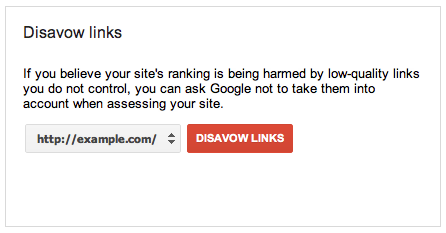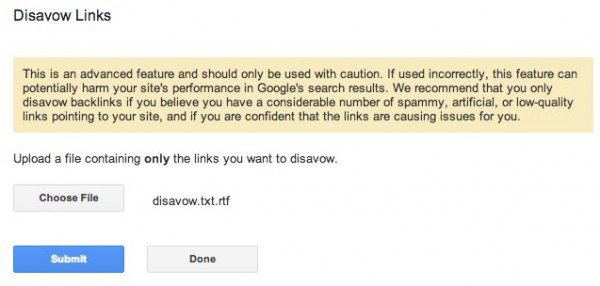 On October 16, 2012 Google introduced a new tool that makes it possible for you to disavow links to your site. As link pruning has become an important part of the recovery from the Penguin algorithm update, many sites that used to charge (or maybe not charge) for adding links, have discovered a profitable business in charging ( $20 – $32 per link in our experience) for removing those low quality, spammy links that are hurting sites. Getting rid of these links is even more time consuming, costly and difficult than building links. Jason White wrote about his experience with analyzing and cleaning up links in his post “Link Building Strategies of Yosemite Sam Meet Google’s Disavow Tool.”
On October 16, 2012 Google introduced a new tool that makes it possible for you to disavow links to your site. As link pruning has become an important part of the recovery from the Penguin algorithm update, many sites that used to charge (or maybe not charge) for adding links, have discovered a profitable business in charging ( $20 – $32 per link in our experience) for removing those low quality, spammy links that are hurting sites. Getting rid of these links is even more time consuming, costly and difficult than building links. Jason White wrote about his experience with analyzing and cleaning up links in his post “Link Building Strategies of Yosemite Sam Meet Google’s Disavow Tool.”
To Disavow or Not to Disavow?
One of our clients, who came to us after they got hit with both Panda and Penguin, was excited to jump in and have us use the Google disavow tool. After some explanation and education, they realized that this tool should not be our first step. It is not a shortcut.

Google’s disavow links tool.
Google has stressed repeatedly (see the video below and on their blog), as have others in the industry, that the disavow tool is powerful and should be used cautiously. Make sure you do everything you possibly can to remove spammy links first. Only after you’ve exhausted those efforts should you turn to Google’s disavow tool.
In other words, it’s best to remove bad links from the web; don’t rely on Google’s tool to discount them. I tend to look at things that are controlled by others very cautiously – that if someone else controls something, you shouldn’t fully depend on them. What if one day Google decides that they will now treat things differently? Google always reserves the rights to treat anything in a way they see fit.
The canonical tag, which can help with duplicate content management, is often used as a band aid for poor information architecture. Similarly, I feel that people need to be careful not to use the disavow tool as a quick fix for not cleaning up their low quality links.
Links Can Affect Your Brand and Reputation
Even if Google discounts your low quality links, the links are still out there. If people, including your prospects, find them they will reflect very poorly on your brand, which could affect their trust in your business. In addition, think about other search engines (present or future) and how your bad links could affect your visibility in them.
Assuming you are in business for the long run, you need to think about the long term implications and the probability that search engines will likely change how they operate. You want to prevent them from taking negative actions in the future because of your questionable link profile. Google is constantly testing and experimenting with the goal of improving searchers’ experiences. They roll out 500 to 600 updates a year in an effort to constantly evolve.
As a result, the only constant in our industry is change so we need to accept, embrace and always be ready for change. As the famous quote, that was never actually written by Charles Darwin but is often attributed to him, says:
“It is not the strongest of the species that survives, nor the most intelligent that survives. It is the one that is most adaptable to change.”
The Penguin algorithm update (which we wrote about and its affect on exact-match domains) and the need for the disavow links tool is an example of how things can change for all of us when Google decides to change the way they treat something. Having lots of links with exact match anchor text was the Holy Grail not that long ago, but Google changed the way they treat them and now site owners need to not only change how they get links, but they also need to invest into cleaning up their link profiles.
More About the Disavow Link Tool
Matt Cutts, head of Google’s web spam team, prepared the video below, in which he discussed the disavow link tool and repeatedly stressed to be cautious about using the tool.
Which Links Would You Like Google to Ignore?
The first step is to assess your backlinks. Then, move on to clean up spammy back links, blog and comment spam, guest post spam, low quality articles, over-optimized keyword-rich anchor text, site-wide links, etc. Google may have sent you an unnatural links message if they saw an indication of paid links or other link schemes.
The main recommendation is to remove as many low quality links from the web as possible. Write to people asking them to remove those links. Sometimes it’s not possible to get in contact and you cannot remove a certain fraction of those links – that is when you can use the tool. Documentation is key: you need to show Google that you tried to clean up your act. The link pruning you do needs to show how many attempts you made to contact them, that you elevated the method of contact (i.e. email first, phone call) and that ultimately the site was either unresponsive or removed the link.
How Does the Disavow Tool Work?
To use the Disavow Links Tool, decide which links to disavow. Go into Webmaster Tools and now you can download your recent links sorted by the date Google discovered them. Look at the most recent links and pay attention if you received any unnatural links warning. Google is looking at ways to include up to three examples of the sorts of links in the warning message that they think are questionable. Keep in mind these are just examples, and not a comprehensive list.
There are disclaimers when you load the tool. Cutts and Google have been emphasizing that most people do not need to use this tool. If you haven’t done any “outrageous SEO,” acquired paid links, and engaged in other link schemes, you should be OK according to Matt Cutts. However, people who claim they have not engaged in “outrageous SEO” have still been impacted. Sometimes, it’s not the most obvious cause.

You will see disclaimers when you go to upload your text file in Google’s disavow links tool.
Disavowing backlinks is a two-step process:
- Download the links to your site from Google Webmaster Tools
- Upload the list of links to disavow
Once you have your list, you’ve analyzed, and done everything you could to remove them from the web, you now have a list of links you need to disavow… here are a few things to know:
- You can upload one text file of the links you want removed.
- Enter one URL per line.
- To ignore all links from a domain, use domain:spamsite.com.
- It is bit tricky with subdomains. For the well-known, established, free hosts like wordpress.com, blogspot.com, tumblr.com, etc., disavowing links from only a subdomain should work for the most part (i.e. spamsite.blogspot.com). If the free host is very new or rare, Google may interpret this as a request to disavow all links from the entire domain.
- Add # and provide comments about your efforts to remove the links.
- You can only have one text file for one domain.
- File size limit is 2mb.
- Google normally canonicalizes index files and variations of domains like http://site.com, http://site.com/ and http://site.com/index.html but if you want to be ultra-safe (which I do!) you should list all URL variations. If you list domain:site.com it should cover links from the www version too.
- To edit, you can download, edit and re-upload the file.
- It will take a few weeks because these pages will have to be re-crawled and re-indexed to attach the attribute to not treat those links the same.

Example of a text file listing links to be disavowed and comments about the efforts taken to remove them.
- Your list of disavowed links will be treated as a very strong suggestion, not as a directive. Google reserves the right to look at things and decide how to treat them. They treat it a lot like the nofollow tag sometimes placed on links.
- If you have been denied reconsideration, this tool may be helpful. Google wants to see that you removed most bad links. If you submit a reconsideration request, let Google know that you have a disavow links list submitted as well so they can check them out during the investigation. Wait with your reconsideration request a few days after you submitted the disavow links. Do not submit a reconsideration request if you haven’t gotten a notice of a manual webspam action.
- You will still need to submit a reconsideration request if you got a manual action message. Using the disavow tool is not a replacement for a reconsideration request.
- When Google looks at a reconsideration requests, they are looking at the set of links that existed before and then doing spot checks and looking if those links are off the web. If you haven’t tried getting any links removed it will confirm for Google that you have been disavowing links without trying to get them taken down. So Matt Cutts recommends not to count on the disavow tool to work in these cases.
- The Google Disavow Links tool is a powerful tool. Only use it if you really have a good reason to think that you need to.
- If you want to un-disavow a link or re-avow a link it will take a lot longer and the link may not get the same weight.
According to Cutts, only a very small number of people are getting the unnatural links warning messages. It is possible to shoot yourself in the foot by using the disavow tool so he encourages everyone to do an audit to get an idea of the spammy links and the links that should count.
Throughout the video, Matt Cutts stresses that people should be approaching the disavow links tool with caution and that you should only turn to this tool after you’ve done all the spammy link cleanup you could do. Good advice.
How Long Before You See Improvements?
It can be months. Your list of disavowed links will need to be crawled and indexed and there will be a time delay until the next algorithm update is rolled out.
Let me know if you need help with any of this or, how it goes when you clean up your bad links using these methods!